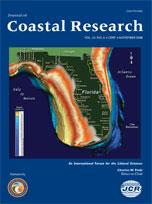Continental shelf environments along the Florida Atlantic southeast coast offshore Palm Beach County were mapped by interpreting seafloor topography derived from airborne laser bathymetry. The study area covered approximately 270 km2 along 75 km of coast, extending from the shore to about 55 m water depth beyond the shelf break to the upper Florida-Hatteras Slope. Forty-two mapping units were used to depict seafloor features that ranged from bedrock outcrops and coral reefs to different types of morphosedimentary bodies. Background theory and protocols of geomorphological symbolization are provided as a rationale for the seafloor mapping. Geomorphological mapping symbols were developed specifically for this project and collected in a symbol library as part of an ArcInfo GIS extension that was used to produce the maps in a GIS environment. Spatial distribution patterns of landform assemblages evident in the color-pattern mapping units permitted regionalization of shelf environments into three primary geomorphological reaches: Reach I, Sand Flats and Karst Topography; Reach II, Sand Flats and Coral Reefs; and Reach III, Sand Flats, Hardgrounds, and Coral Reefs. The main hardbottom mapping units include rock outcrop and subcrop, rock rubble, ridge fields, and structural sand flats. Sandy nontidal morphosedimentary bodies include diabathic channel fields, dune fields, sand flats, and bar and trough systems. Tidal morphosedimentary features include ebb-tidal deltas, sandbars, and lobe bars. Results of this mapping effort showed that it is possible to map marine and drowned terrestrial landforms on the continental shelf as depicted in high-resolution airborne laser bathymetry. Adaptation of existing symbols or development of specialized symbolization was required to show geomorphic units to advantage. These maps, which characterize shelf environments, are contextualized in terms of shapes, forms, materials, and coastal process zones. These types of maps find immediate application in regional and detailed sand searches for beach renourishment, subsea cable and pipeline routes, wave and current modeling studies, and environmental management.
BioOne.org will be down briefly for maintenance on 14 May 2025 between 18:00-22:00 Pacific Time US. We apologize for any inconvenience.
How to translate text using browser tools
1 November 2008
Geomorphological Mapping along the Upper Southeast Florida Atlantic Continental Platform; I: Mapping Units, Symbolization and Geographic Information System Presentation of Interpreted Seafloor Topography
Charles W. Finkl,
Jacob Estebanell Becerra,
Victoria Achatz,
Jeffrey L. Andrews
ACCESS THE FULL ARTICLE
airborne laser bathymetry
bathymetry
Beach
bottom types
coastal geology
continental shelf
Coral reef





